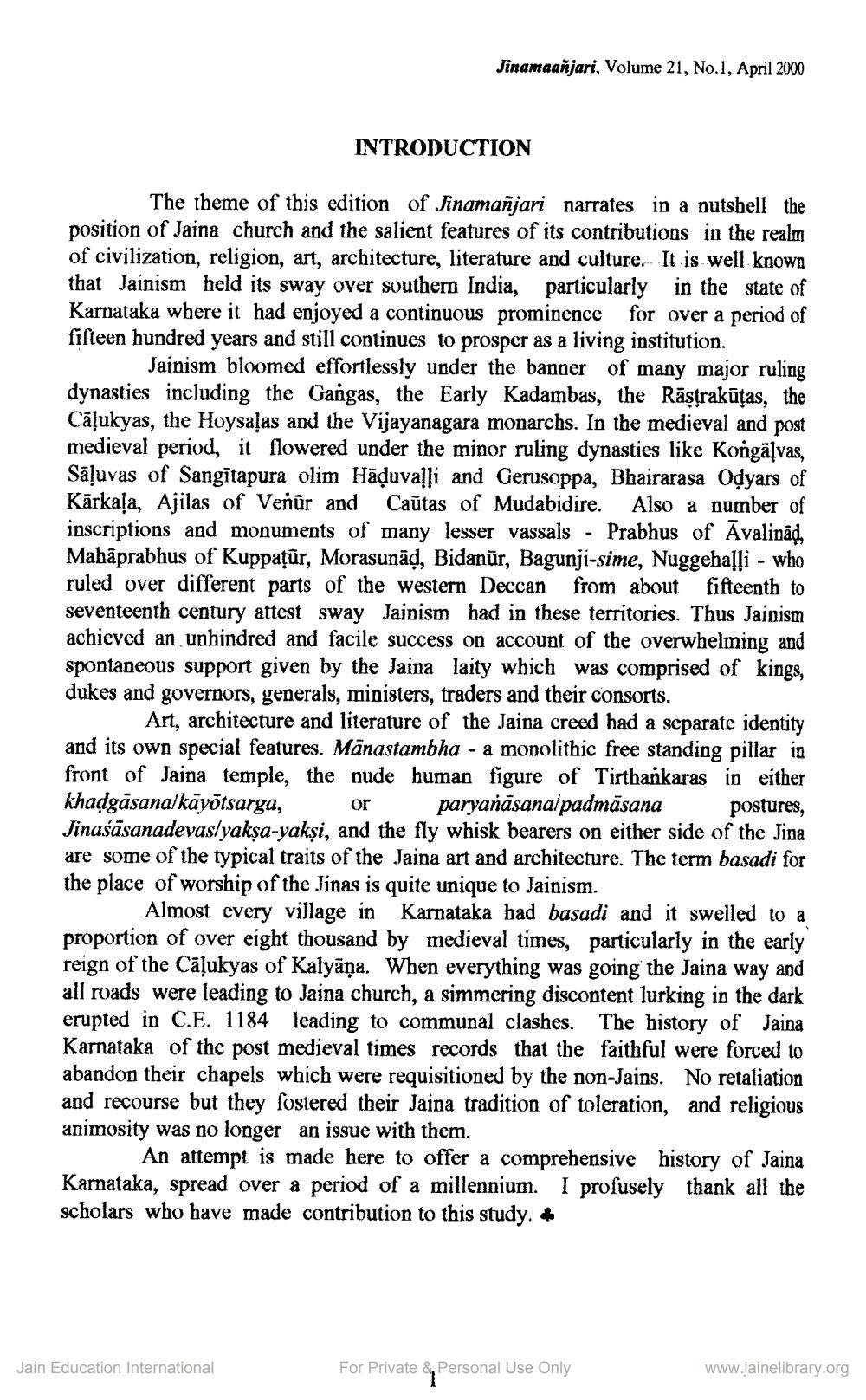Book Title: Jinamanjari 2000 04 No 21 Author(s): Jinamanjari Publisher: Canada Bramhi Jain Society Publication View full book textPage 4
________________ Jinamaañjari, Volume 21, No.1, April 2000 INTRODUCTION The theme of this edition of Jinamañjari narrates in a nutshell the position of Jaina church and the salient features of its contributions in the realm of civilization, religion, art, architecture, literature and culture. It is well known that Jainism held its sway over southern India, particularly in the state of Karnataka where it had enjoyed a continuous prominence for over a period of fifteen hundred years and still continues to prosper as a living institution. Jainism bloomed effortlessly under the banner of many major ruling dynasties including the Gangas. the Early Kadambas. the R Cāļukyas, the Hoysalas and the Vijayanagara monarchs. In the medieval and post medieval period, it flowered under the minor ruling dynasties like Kongālvas. Sāļuvas of Sangītapura olim Hāļuvalli and Gerusoppa, Bhairarasa Odyars of Kārkaļa, Ajilas of Veñūr and Caūtas of Mudabidire. Also a number of inscriptions and monuments of many lesser vassals - Prabhus of Āvalinā, Mahāprabhus of Kuppațūr, Morasunāð, Bidanūr, Bagunji-sime, Nuggehalļi - who ruled over different parts of the western Deccan from about fifteenth to seventeenth century attest sway Jainism had in these territories. Thus Jainism achieved an unhindred and facile success on account of the overwhelming and spontaneous support given by the Jaina laity which was comprised of kings, dukes and governors, generals, ministers, traders and their consorts. Art, architecture and literature of the Jaina creed had a separate identity and its own special features. Mānastambha - a monolithic free standing pillar in front of Jaina temple, the nude human figure of Tirthankaras in either khadgāsana/kāyotsarga, or paryanāsanalpadmāsana postures, Jinaśāsanadevas/yakşa-yakși, and the fly whisk bearers on either side of the Jina are some of the typical traits of the Jaina art and architecture. The term basadi for the place of worship of the Jinas is quite unique to Jainism. Almost every village in Karnataka had basadi and it swelled to a proportion of over eight thousand by medieval times, particularly in the early reign of the Cāļukyas of Kalyāņa. When everything was going the Jaina way and all roads were leading to Jaina church, a simmering discontent lurking in the dark erupted in C.E. 1184 leading to communal clashes. The history of Jaina Karnataka of the post medieval times records that the faithful were forced to abandon their chapels which were requisitioned by the non-Jains. No retaliation and recourse but they fostered their Jaina tradition of toleration, and religious animosity was no longer an issue with them. An attempt is made here to offer a comprehensive history of Jaina Karnataka, spread over a period of a millennium. I profusely thank all the scholars who have made contribution to this study of Jain Education International For Private Personal Use Only www.jainelibrary.orgPage Navigation
1 2 3 4 5 6 7 8 9 10 11 12 13 14 15 16 17 18 19 20 21 22 23 24 25 26 27 28 29 30 31 32 33 34 35 36 37 38 39 40 41 42 ... 88
